Retirement Planning Special Needs Planning Insights
Long-Term Care Trends and Strategies

According to the most recent iteration of the Retirement Income Literacy Study, a survey conducted by The College every four years to measure older Americans’ financial literacy in 12 knowledge areas related to retirement income, one of the top areas of concern facing Americans as they head toward retirement is paying for long-term care. A number of factors contribute to this, including cuts in Social Security, inflation, and the rising costs of healthcare.
However, despite their concerns related to long term care, many Americans have not reflected it when making their plans for retirement. In fact, a staggering nearly 80% of respondents did not have a plan in place to fund their long-term care needs. Furthermore, 60% of respondents stated they had not even looked into policies or explored their long-term care options. As a reminder, these respondents were between the ages of 50 and 75, meaning that three in five Americans between the ages of 50 and 75 had not even given serious consideration to their long-term care needs in any capacity.
Additionally, the study found that a significant number of Americans severely underestimated their need for long-term care, with only 44% of survey respondents expecting they would need long-term care as they grow older. In reality, Americans need some form of long term care at a rate of 70%. According to James Karthaus, CFP®, CLU®, ChFC® these numbers represent “nothing less than a crisis.”
“This is not an industry statistic. This is a governmental statistic, and it’s actually a little dated. … 70% of folks 65 and older are going to need some type of long term care service. … The average, not the high end, is three years. … 80% of folks don’t have a plan. To me, that’s nothing less than a crisis.”
- James Karthaus, CFP®, CLU®, ChFC®
In this discussion, featured in a recent webcast hosted by The College on their subscription-based learning platform Knowledge Hub+, Kaylee Ranck, PhD, director of research at The College, Karthaus, assistant professor of financial planning at The College, and Joellen Meckley, JD, MHS, ChSNC®, managing director of the American College Center for Special Needs and associate vice president of Centers strategy and operations at The College explored this disconnect between the average American’s expectations and the realistic need for long-term care, reviewed how exactly long-term care is defined, analyzed trends in the industry relating to long-term care, and discussed several real world examples relating to long-term care.
What is Long-Term Care?
In order to better understand the discrepancy between Americans’ expectations and the realities of long-term care, Meckley provided the audience with additional information as to what exactly long-term care is and how to determine if someone is in need of long-term care. According to Meckley, long-term care occurs when an individual needs assistance with two or more activities of daily living. These activities include:
- bathing
- dressing
- eating
- toileting
- transferring / mobility
- continence
Meckley also pointed out long-term care manifests in a number of different forms and the long-term care one person receives can look significantly different than what another individual receives. These different forms of long-term care can include in-home care, hospice care, and therapy, as well as others.
As Karthaus said, these different forms of long-term care are important to consider when choosing a policy that suits the goals of your client. “Make sure, if you do elect a policy, you’re meeting the clients in the space they want to be,” he said. “If they want to go to an assisted living facility, fantastic. Just make sure the policy that you’re paying for or having them pay for, can meet them where they want. If they want to be at home … (with) an unpaid caregiver, they need informal care on their policy.”
Trends in Long-Term Care
Karthaus went on to emphasize the importance of considering trends in long-term care and the history of different policies when electing the one that best suits your client. Karthaus offers comparisons between traditional long-term care insurance, hybrid policies, life insurance policies with long-term care access, employer-sponsored long-term care insurance policies, and others. Each of these has a variety of pros and cons, and he said it’s important to measure these when considering which policy is the best fit.
Meckley explained what happens when clients actually begin needing long-term care, indicating that many people seem to be unprepared for the experience:
“Only one in three … respondents to our survey knew that it was not true that Medicare would pay for a year of nursing home care. … That’s often shocking to people. So there’s a huge knowledge gap out there. And unfortunately, it’s not just with clients, it’s also within the profession.”
Meckley continued by discussing other issues people face when attempting to use long-term care benefits, warning individuals of the 90-day elimination period in which they are waiting on long-term care benefits to become active, issues brought on by inflation, and the likelihood that an individual in need of long-term care will likely see that need increase over the course of their life, thereby seeing an increased cost they may not be prepared to pay.
Want to learn more about this important topic? Watch Ranck, Karthaus, and Meckley as they discuss the importance of long-term care, different forms of long-term care policies, and the challenges that can arise within families as the need for long-term care arises. Meckley also offers case studies that can be used to apply this knowledge during the discussion, allowing for a more interactive learning experience. You can gain access to this informative discussion on Knowledge Hub+, now available for free to members of The College’s Professional Recertification Program and as an open subscription to others!
Retirement Planning Special Needs Planning Podcasts
Ensuring Equality in Retirement Planning

In this episode of our Shares podcast, host Joellen Meckley, JD, MHS, ChSNC® joins Ramsey Alwin, president and CEO of the National Council on Aging (NCOA), for a candid conversation on how older Americans – especially women – often face increasing financial challenges as they age. They also discuss new research from NCOA on economic stress among seniors and their caregivers, including saving for retirement, diminishing decision-making capacity, and more.
Ramsey Alwin is president and CEO of the National Council on Aging (NCOA), leading a nationwide movement to ensure equitable aging for every American. A seasoned thought leader and policy advocate, she designed a new measure of economic security for older adults that better accounts for out-of-pocket health costs and worked to introduce the Measuring American Poverty Act in Congress to redefine the federal poverty measure for the older population. Thanks to Alwin’s efforts, the U.S. Census Bureau formally implemented the Supplemental Poverty Measure nationwide, virtually doubling the elder poverty count and better demonstrating true needs among this population. She also led and organized efforts to enact state and local legislation and regulations that use the new measure of economic security when determining eligibility for means-tested programs.
Currently, Alwin serves on the executive committee of the United Nations NGO Committee on Aging, the America250 Health and Wellness Advisory Council, CVS Health Equity National Advisory Board, and the National Academy of Social Insurance Finance Committee. Alwin holds a Bachelor of Arts from Simmons University and a master’s degree from the McDonough School of Business at Georgetown University.
Any views or opinions expressed in this podcast are the hosts’ and guests' own and do not necessarily represent those of The American College of Financial Services.
Financial Planning Retirement Planning Research
Retirement: The Power of Tracking
If you’ve used a fitness app, you may have noticed that activity goal reminders motivate you to exercise. Reminders force us to make active choices. Are you okay with not meeting your step goal today? Have you exercised less this month than you did last month? Are your friends working out more often than you are?
Academics have generally embraced the power of doing nothing in 401(k) plans. The Pension Protection Act of 2006 increased the percentage of employees who sock money away for retirement at the default savings rate and 68% of employees now invest in target-date funds (ICI, 2024). Defaulting to passive savings means that more workers save and the least knowledgeable save more and earn a higher rate of return on investments than if they made active choices.1
A recent survey from the American College Granum Center for Financial Security conducted with AGEIST.com finds that people who track their health are also more motivated to save for retirement. This makes sense if the real power of tracking is that it forces us to make an investment in our ability to imagine the future and take control of decisions today that affect how long and how well we will live decades into the future.
Nobel Laureate Gary Becker (1997) believed that the time and effort we spend imagining how decisions today affect future outcomes is an investment. If we spend more time thinking about how our actions today impact, for example, how much money we can spend after retirement or whether we will be physically active in our 70s and 80s, then we can make better decisions about how much to save and exercise. Imagination is a resource that helps us make better decisions.
While imagination helps us recognize the future consequences of our decisions, we might forget about these consequences when we wake up in the morning and follow a routine that doesn’t include exercise. This is because the brain often operates in automatic mode where habits control how we spend much of our day.
Breaking out of habits requires conscious choice. This is where tracking comes in.
Using tracking devices forces a break in our habits. After we wake up and brew a cup of coffee, our tracker reminds us to at least think about going for a run. If you’ve built the imagination capital that allows you to recognize the importance of running today to increase your health and longevity, then you might decide to get some exercise. In other words, imagination capital alone isn’t enough to reach your goals. You need a tool that helps you change habits.
We all face a struggle between what we do today and what we want in the future. In economics, this is referred to as “time inconsistent preferences.” In other words, we may want to save more for retirement, but when we get to work, we don’t walk down to the benefits office to increase our savings rate. We might want to be healthier, but can’t resist choosing a burger instead of a grilled chicken salad at the cafeteria. Smart people who value the future recognize that they need a little help to make better choices in the present.
Effective trackers give us a short-term boost of positivity when we do something that helps us meet long-term goals. They might congratulate us for reaching our step goal or encourage friends to give us kudos for going on a run. The best trackers leverage the power of short-term emotion to motivate small behavioral changes that result in big, long-run improvements toward our goals.
Tracking progress in retirement can also give us a boost as we see our savings grow over time. The positive emotional response we get from seeing our nest egg grow can motivate us to save more. If we never check our balance, we may forget about the importance of savings and investing. Tracking can provide a short-term reward and remind us that we need to stay on track to meet long-term retirement security goals.
Do People Who Track Save More for Retirement?
Yes, quite a bit more. More than half of survey respondents who check their retirement balance daily (13% check daily!) save more than 10% of their income for retirement. Those who check their balance weekly or monthly were about 30% more likely to save 10% of their income for retirement than those who check quarterly or annually, and only 10% of those who never checked their balance saved more than 10%.
Save More Than 10% for Retirement
How often do you check your retirement savings balance?
Is tracking associated with taking the time to estimate how much savings is needed to meet retirement spending goals? Yes, more than 80% of respondents who check their balance daily, and 67% of those who check their balance at least every month have made the effort to estimate how much they need to save to meet retirement spending goals. Only 14% of those who never check their balance have estimated how much they’ll need to save to meet retirement spending goals. Those who track progress have also taken the time to imagine how much they will need to save to meet their future spending goals.
Have Estimated Savings Needed to Meet Retirement Spending Goals
![]()
How often do you check your retirement savings balance?
Those who track their retirement balance are also more likely to track their health. Tracking health using a wearable device (such as an Apple watch, Oura ring, Fitbit, etc.) is strongly associated with tracking one’s retirement savings balance. Both health and retirement savings are short-run behaviors that lead to positive long-term outcomes. It’s not surprising that those who make an effort to measure progress toward health goals also track progress in their finances.
Track Health Using a Wearable?
How often do you check your retirement savings balance?
Do those who follow a specific plan or health app save more for retirement? The results are striking – just over half of those who follow a specific workout plan or app save more than 10% of their income for retirement. Only a quarter of those who don’t follow a workout routine save at least 10%. Those who have created a habit of exercising have also made a habit of saving 10% of their income for retirement.
Save More Than 10% for Retirement
Do you have a workout routine?
Before diving into retirement planning as a math problem, it might be more important to help a client imagine how they’re going to live in retirement, what they hope to spend money on, and how this spending will open up opportunities for travel, moving into a dream home, or achieving financial security or a legacy goal. Conversations that build imagination capital can help individuals see how small choices today can lead to a better life in the future.
Likewise, people save more when they track short-term progress. Seeing one’s savings rise over weeks and months can trigger positive emotions and a feeling of accomplishment. In fact, there appears to be similarities in tracking health and the propensity to create specific short-term plans and saving more for retirement. Tracking motivates active choices in both health and retirement that lead those who value the future to be rewarded for making decisions in the present.
There may be a dark side of tracking that doesn’t show up in these results. In March 2020, workers who managed their retirement investments were far more likely to phone up their recordkeeper after the market dropped to sell stocks after they fell in value. Target-date fund investors were generally unaware of the drop and didn’t make a change in their investments. Access to an advisor, however, increased the probability of initiating contact and significantly reduced the likelihood of an ill-timed trade. If frequent trackers are more aware of a loss, they’ll likely benefit more from the counsel of an advisor who can help them manage their emotions and maintain savings habits to meet long-term goals.
Retirement Planning Wealth Management Podcasts
Retirement Income Strategy Smackdown
In this episode of our Shares podcast, recorded on the floor of AICPA Engage 2024, host Michael Finke, PhD, CFP® welcomes fellow College professor and former podcast co-host David Blanchett, PhD, MSFS, CFA, CLU®, ChFC®, CFP® to the hot seat for a discussion on one of their favorite topics: comparing what's good and bad about various retirement income planning strategies. For listeners of the former “Wealth, Managed” podcast, it’s like a reunion special! Listen as they explore the differences between fixed and flexible approaches, and the best ways to address risks.
David Blanchett, PhD, MSFS, CFA, CLU®, ChFC®, CFP® is adjunct professor of wealth management at The American College of Financial Services. A world-renowned thought leader in the fields of wealth management and retirement, Blanchett is a leading contributor to the Wealth Management Certified Professional® (WMCP®) Program.
In addition to his role with The College, Blanchett is the managing director and head of retirement research at QMA, a division of Prudential Financial, and was formerly at Morningstar Investment Management, LLC. In his roles, Blanchett enhances consulting and investment services and conducts research primarily in the areas of financial planning, tax planning, annuities, and retirement. Blanchett has published research in a variety of academic and industry journals and has been featured in multiple media publications, such as InvestmentNews, Marketwatch, Money Magazine, The New York Times, PLANSPONSOR Magazine, and The Wall Street Journal.
Any views or opinions expressed in this podcast are the hosts’ and guests' own and do not necessarily represent those of The American College of Financial Services.
The Human Factor in Advising
In this episode of our NextGen in 10 podcast, host Clarisa Hernandez, CFP®, ChFC® speaks with Jeff Landt, CFA, CFP® about how an advisor's value to a client is sometimes difficult to quantify, yet those who get professional advice have more clearly defined life goals and better investing outcomes.
Jeff Landt, CFA, CFP® is a senior vice president and the chief investment officer for North Star Resource Group. His primary area of expertise is the investment management process. He assists the firm’s associates with portfolio strategies, portfolio construction and the best practices of portfolio management. In addition to acting as the chief investment officer, he is also a practicing associate with North Star Resource Group, specializing in retirement distribution strategies and wealth management.
Any views or opinions expressed in this podcast are the hosts’ and guests' own and do not necessarily represent those of The American College of Financial Services.
Financial Planning Philanthropic Planning Retirement Planning Insights
FinServe Ambassador Charts Career Evolution Through Specialization

Tudor says he entered the financial services profession via banking in 2008 during a volatile and chaotic time for the industry. Despite this, he says he found great satisfaction in his work in leadership roles – running several bank branches around Cincinnati, Ohio – and especially in areas involving lending. That was where he first started to sense the industry might have blind spots and think about how he wanted to address them.
“I really enjoyed helping people buy houses and start small businesses, but I saw gaps in knowledge and access, especially when it came to investment management,” he said. “The bank often had a minimum level of assets they would service, and I often saw more resources being afforded to affluent communities. I knew I wanted to focus on those who had been historically excluded.”
Tudor eventually transitioned into a role with Northwestern Mutual and spent several years at the company becoming a licensed advisor and directly working with clients. From those interactions, he continued to refine his sense of who he was as a professional and who he wanted to serve.
“Most people, especially those from historically excluded communities, need more education in and access to financial services and are looking for deeper advice than just receiving products,” he said. “I’ve always felt we should be building in systems to protect and educate these groups.”
In 2020, amid the COVID-19 pandemic, Tudor finally decided he wanted to start his own firm and launched Alchemist Wealth – with a focus on fee-only planning and serving women and other historically excluded communities – with his brother. Four years later, he merged the successful practice into Zenith Wealth Partners, where he continues to work as an advisor in a variety of planning fields, from investment portfolios to retirement and philanthropic planning. It’s all in service, he says, of his mission to help his clients align their money with their values.
The Role of Retirement Planning
While at Northwestern, Tudor availed himself of the company’s connection to The College to earn multiple designations and certifications: first through the CFP® Certification Education Program to get a strong financial planning foundation, and later through the Retirement Income Certified Professional® (RICP®) Program for the specialization he was seeking in retirement preparation and planning.
“The first time a client came to me and asked me questions about retirement I couldn’t answer, I knew I had to get more knowledge,” he said. “The RICP® is powerful because it impresses upon you that accumulation planning and retirement income planning are two very different things. When I was at Northwestern, we would answer questions about retirement planning with material from College thought leaders like Michael Finke, PhD, CFP® and Wade Pfau, PhD, CFA, RICP®. Their advice on using tools like annuities, home equity, and other income streams to stabilize retirement income may not be popular in some circles, but they’re mathematically proven to be better solutions.”
“[The RICP® Program]’s advice on using tools like annuities, home equity, and other income streams to stabilize retirement income may not be popular in some circles, but they’re mathematically proven to be better solutions.”
Tudor says thanks to the RICP®, he is now well-versed in retirement planning concepts and can simplify them enough for his clients to understand. He also says he sees a growing need for this specialized knowledge as America continues to age.
“The industry to me is still five to 10 years behind what’s necessary in retirement income planning, and it’s exciting to see The College continue to be out in front of the latest ideas and blaze the trail for doing things the right way,” he said.
Investing for Impact
In addition to his focus on retirement planning, Tudor says he’s always been interested in the technical side of planning and the potential of money in general to benefit society. Because of this, he enrolled in the Chartered Advisor in Philanthropy® (CAP®) Program at The College to gain more specific knowledge about how to use investment strategies to help his clients live their values.
“We often ask clients about their goals for impact: whether they’re broad or specific, for family, community, globally, or causes they support,” he said. “Clients constantly bring these subjects up, and I don’t know how I would be an advisor without being able to have those conversations. I believe eventually those kinds of conversations will be table stakes for the industry, and everyone will need to know how to talk about charitable giving with clients and organizations.”
While he loves working directly with clients, Tudor says it’s the institutional side of giving that he’s fallen in love with thanks to the CAP® Program.
“It’s about how you use money and make it work for what you believe in the real world, not just on your spreadsheet,” he said. “That kind of mission-aligned investing, where organizations use their capital to benefit society, is exactly where I want to be. The CAP® Program’s donor strategies were helpful, but its full course dedicated to working with nonprofits has allowed me to sit on board committees and lead conversations about aligning investment portfolios with an organization’s mission. I think that’s a serious gap in the market to be addressed.”
“[The CAP® Program] has allowed me to sit on board committees and lead conversations about aligning investment portfolios with an organization’s mission. I think that’s a serious gap in the market to be addressed.”
Finding Community and Purpose
After being inaugurated into The College community as a recipient of the NextGen Financial Services Professional Award, Tudor says he has been consistently impressed by what The College is able to do for financial professionals – especially in its events like the annual Conference of African American Financial Professionals (CAAFP).
“CAAFP feels like a homecoming every year for me,” he said. “It’s my one opportunity to see and reconnect with a lot of people I know from the industry, and the workshop and keynote sessions are consistently incredible. It’s a safe bet for me to invite a new advisor to CAAFP. There aren’t many places Black professionals in financial services can go and see mostly people who look like them, and the level of excellence in the execution of the event is always impressive.”
“It’s a safe bet for me to invite a new advisor to CAAFP. There aren’t many places Black professionals in financial services can go and see mostly people who look like them.”
Tudor says he’ll be present at this year’s CAAFP, to be held August 12-14 in Atlanta, Georgia. In the meantime, he advises young professionals in the field to be open to challenging themselves and thinking intentionally about their career path.
“Go to places that stretch you and be mindful of how you feel when you’re doing things,” he said. “This field affords you 40 years to build a career and have an impact, so thinking long-term is key. I love working with personal clients and enjoy financial planning in general, but I really live for doing organizational and institutional planning. Fill your day with things you enjoy doing, and success will come.”
Planning for a Longer (and More Expensive) Retirement

How long is retirement going to last?
Underestimating life expectancy is a problem for all older Americans, but especially for higher-income Americans, who have made significant gains in longevity after the age of 65. A longer retirement is a more expensive retirement, and financial planners need to understand how long their clients are likely to live and develop strategies for funding longer lifestyles.
Most people have a vague idea of how long they are likely to live in retirement. It’s common to think of the age our parents or grandparents died when estimating our own longevity. In reality, longevity after the age of 65 increased by about a year every decade in the 20th century, and higher-income Americans can expect to spend significantly more years in retirement.
According to the Social Security Administration mortality tables, half of American men who have reached age 65 will live to at least age 85 and half of women will live to at least age 88. Respondents to the 2023 Retirement Income Literacy Study were asked how long an average 65-year-old man could expect to live. Only 27% selected the correct answer (20 years), 32% thought the average man would live to age 80 (15 more years), 23% believed only 10 more years, just 6% thought an average man would live to age 90, and 12% indicated that they didn’t know.
Respondents’ Expected Longevity of a 65-Year-Old Man
Figure 1
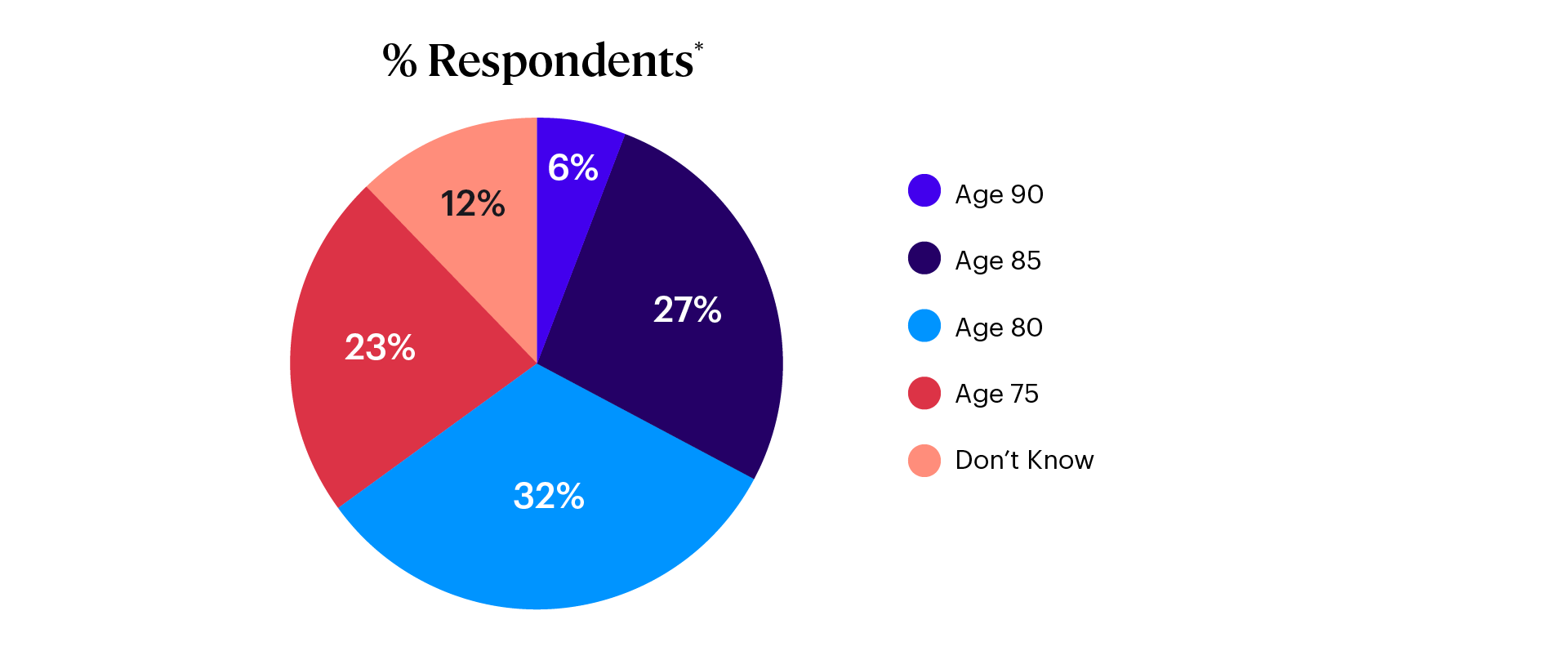
Most Respondents* underestimate or don't know the expected longevity of a 65-year-old man, which is about 20 years (age 85).
In other words, 55% of respondents underestimated retirement longevity and an additional 12% didn’t know. Just a third of respondents (33%) had an accurate or optimistic idea of retirement longevity.
Those who had an unrealistically low expectation of retirement longevity were far more likely to indicate they plan to claim Social Security income benefits before the age of 65. Why is this important? Social Security is the only inflation-adjusted income source most retirees have. Claiming early reduces a retiree’s income for his lifetime and weakens an important source of guaranteed income for workers, many of whom no longer receive employer pensions.
While 42% of those who believed that retirement for a 65-year-old man would only last 10 years expected to claim before age 65, only 33% of those with an accurate estimate of expected longevity planned to claim Social Security early and only 26% of those who overestimated longevity planned to claim before age 65.
Percentage Planning to Claim Social Security Before Age 65 by Longevity Expectations
Figure 2
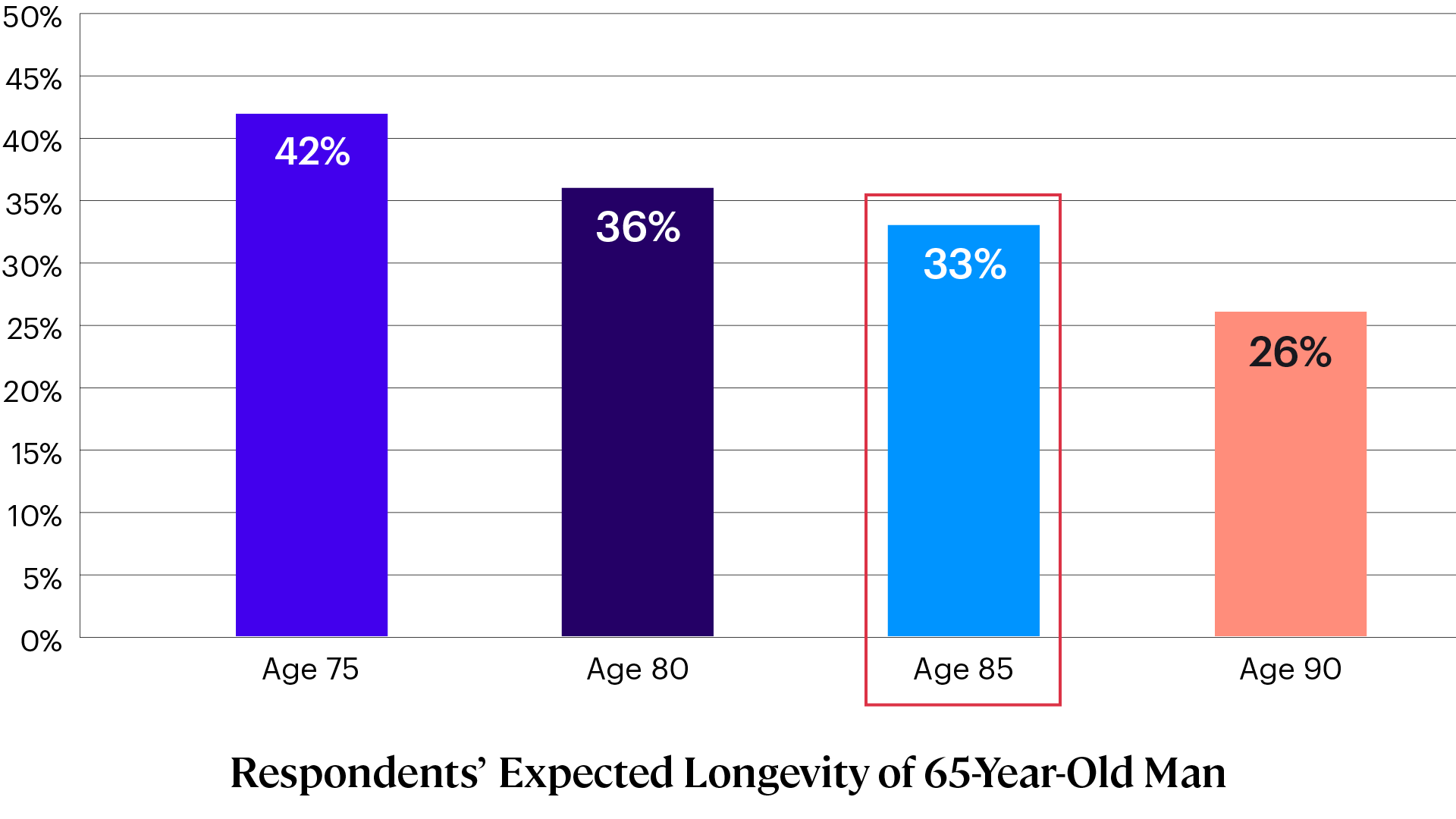
Respondents* who plan to claim Social Security before age 65 are more likely to underestimate the life expectancy of a 65-year-old man. Those who accurately estimate or overestimate a man’s life expectancy (age 85 or higher) are less likely to plan to take Social Security before age 65.
When people are asked “What is the maximum age you would plan for your savings to last in retirement before you run out of money?,” 54% more of those who had an accurate or optimistic idea of expected longevity chose a maximum planning horizon into their 90s compared to those who underestimated longevity.
Percentage Planning for Spending Into Their 90s by Longevity Expectations
Figure 3
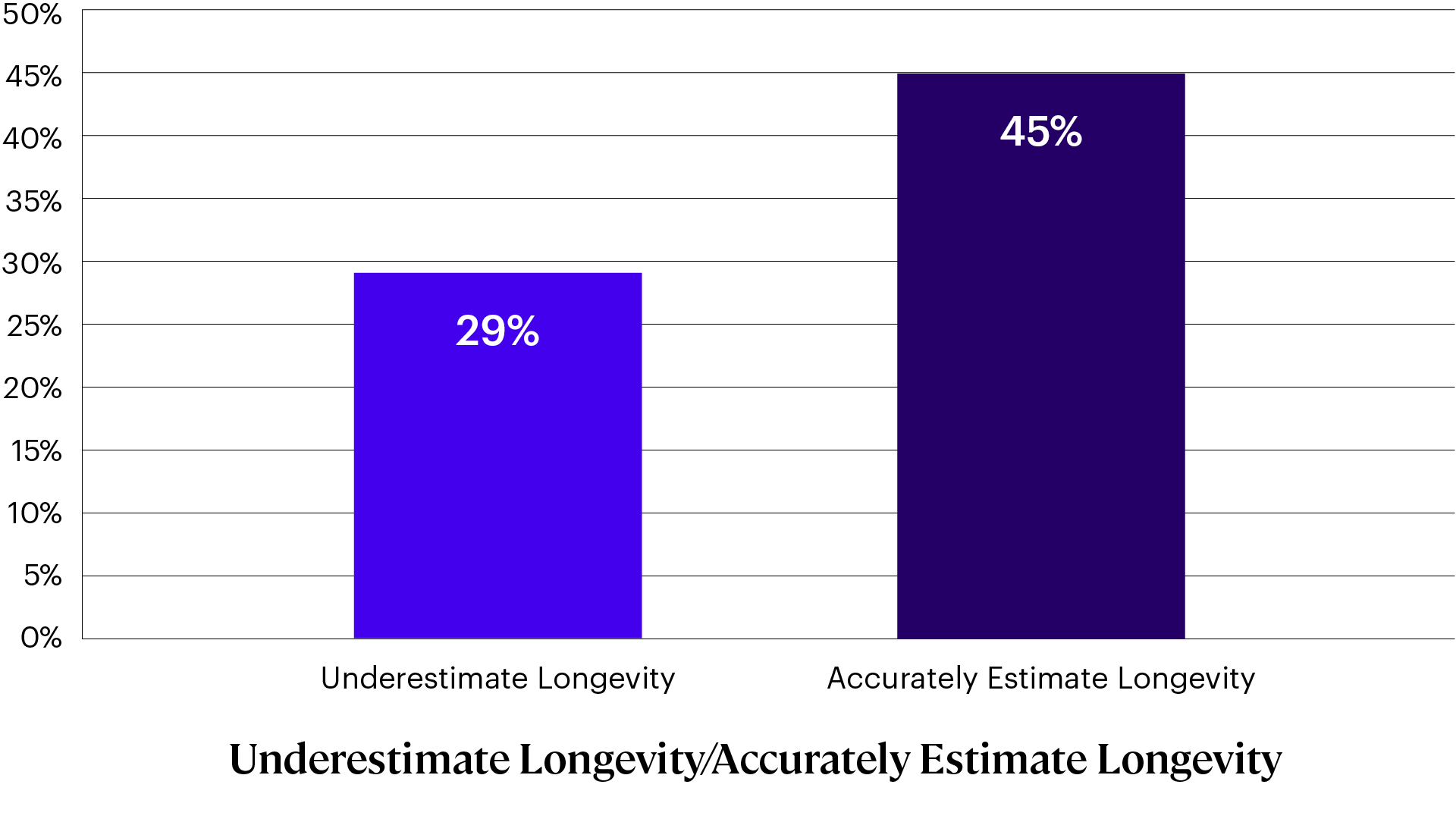
Respondents* who plan for their spending to last into their 90s before running out of money are more likely to provide accurate estimates of the life expectancy of a 65-year-old man.
Financial Planning Clients Live Longer
The survey respondents who thought that a 65-year-old man could expect to live 25 years in retirement weren’t wrong for higher-income men. Men and women whose incomes are high enough to work with a financial advisor have made significant gains in retirement longevity in recent decades. Stanford economist Raj Chetty and his co-authors1 found that life expectancy among Americans in the top 5% of income increased 2.34 years for men and 2.91 years for women between 2001 and 2014, compared to just 0.32 years for men and 0.04 years for women in the bottom 5%.
The improvement in longevity among higher-earning Americans is largely due to differences in health-related behaviors. The most notable difference is in rates of smoking, which dropped significantly for higher-income men and women in the United States. Higher-income Americans are also more likely to exercise, eat better diets, and have access to higher-quality healthcare.
Longevity is subject to the laws of statistics. This means that the number of years you’ll spend in retirement looks like a bell curve with a left tail of unlucky retirees and a right tail of those who live into their 90s and beyond. You’re probably going to live longer than your parents. This means that the entire bell curve needs to be pushed a few more years to the right. It also means that today’s healthy retiree will have to fund more years of spending on average, and more than a few will be around into their late 90s and 100s.
To better understand the difference in the probability of the types of higher-earning individuals (who are more likely to be financial planning clients) being alive at various ages, consider the following table that compares average Americans using the 2017 Social Security Administration mortality table and the 2012 Society of Actuaries annuity mortality table adjusted for expected improvement to the present day. Annuity buyers tend to live longer because they are in the group of higher-income, healthier Americans who have accumulated enough savings to buy a lifetime income.
Probability of Being Alive at Various Ages for 62-Year-Olds
Table 1
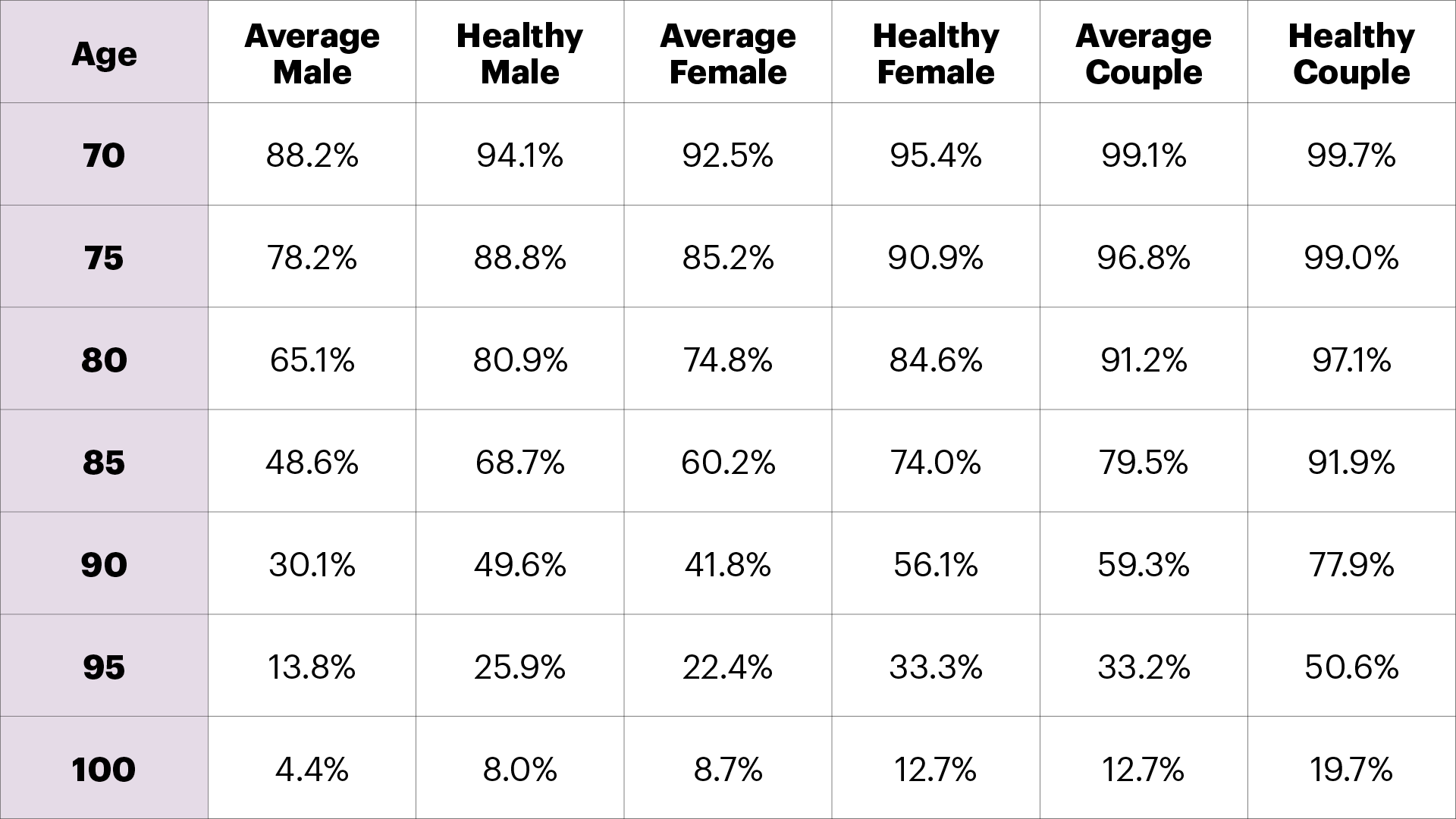
Americans who buy annuities tend to live significantly longer than Americans overall. For example, a healthy male is twice as likely (8%) as the average male (4%) to live to age 100.
It’s obvious from Table 1 that healthier, higher-income retirees need to plan for a longer retirement than the average American. A healthy 62-year-old man is 65% more likely to be alive at age 90 than the average American. One-third of healthy 62-year-old women can expect to live to the age of 95, and half of healthy couples will have one spouse who lives longer than 95 years.
The percentages from Table 1 can also be seen as failure rates. If financial advisors create spending plans in which their clients’ money lasts to the age of 90, then half of healthy men, 56% of healthy women, and 78% of healthy couples will outlive their savings.
The traditional failure rate methodology in financial planning considers a withdrawal rate safe if the money lasts to the age of 95. For a healthy couple retiring today, this yardstick can’t be considered safe if half of them will have at least one spouse who lives beyond the age of 95. Even if the money lasts to the age of 100, one in five healthy couples will outlive their savings.
For a healthy couple retiring today, this yardstick [of making money last through age 95] can’t be considered safe if half of them will have at least one spouse who lives beyond the age of 95. Even if the money lasts to the age of 100, one in five healthy couples will outlive their savings.
A Long Life is More Expensive
An easy way to see how much more money a retiree needs to save to fund a longer retirement is to estimate the cost of creating a base of income that lasts to various ages using safe investments. Returns on financial assets are generally variable, but it is possible to buy Treasury bonds that will mature and provide a future income that isn’t subject to investment risk.
Figure 4 compares the cost of buying a safe income using Treasury bonds to the age at which a healthy man, woman, and couple has a 20% chance of outliving their savings (i.e., 80% probability of success) using yields on April 12, 2024. For example, an average 65-year-old man has a 20% chance of reaching the age of 93 years. The cost of funding $20,000 of income from Treasury bonds at today’s yields will be $315,578. A healthy man has a 20% chance of living to the age of 96 years. It will cost him $332,455 today to buy the same $20,000 of income to an age at which he has a 20% chance of “failure.”
The Cost of Funding $20,000 Treasury Bond Income*
Figure 4
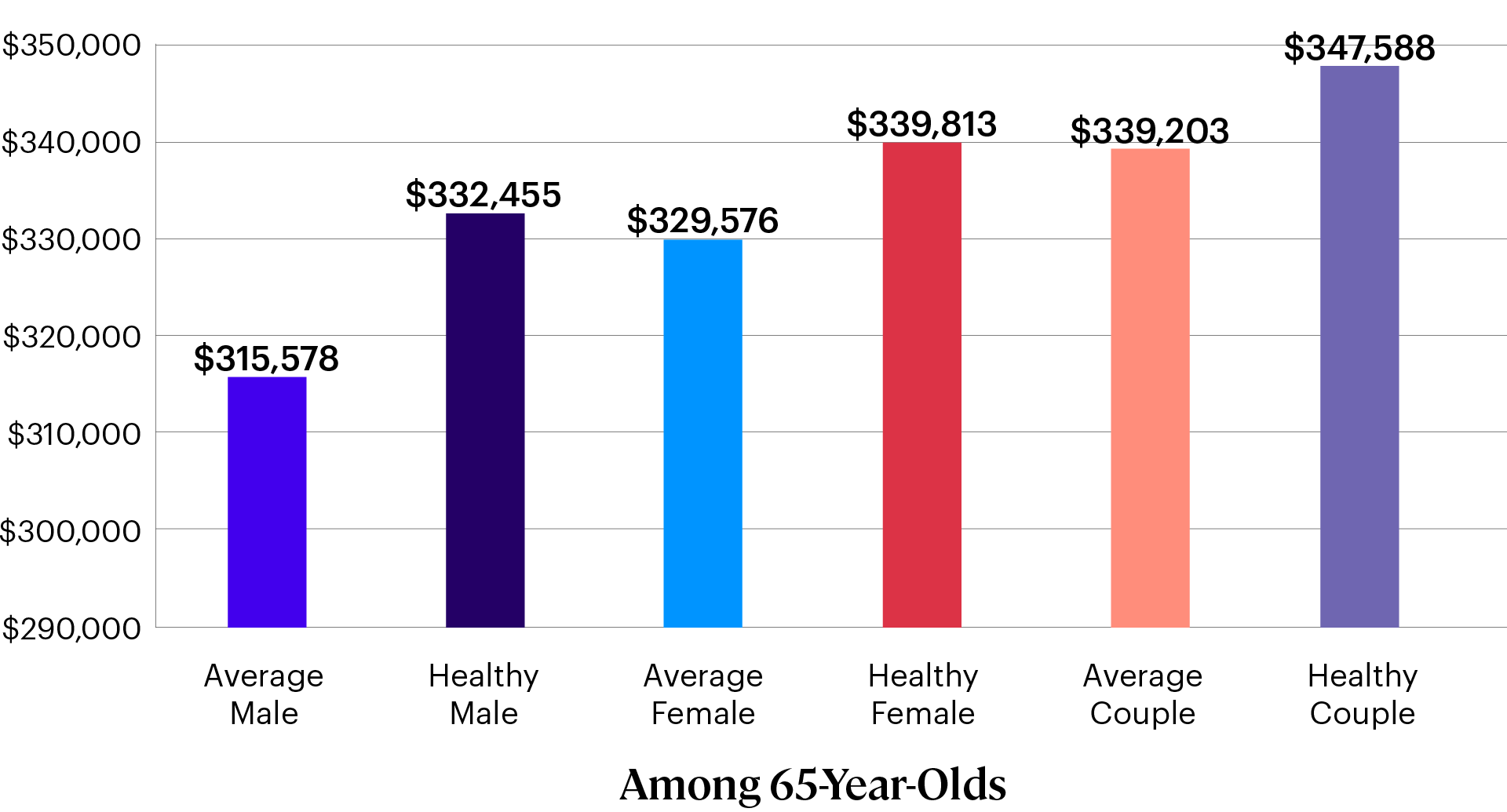
As Figure 4 shows, the cost of income is higher for healthy men, women, and couples who need to plan to fund more years of spending in retirement. This means that healthier and wealthier individuals will have to save more to fund the same lifestyle with an 80% probability of success.
Healthy Americans will have to save more to fund more years of spending in retirement.
Figure 5 shows the cost of funding $20,000 of inflation-protected income using Treasury Inflation Protected Securities (TIPS). TIPS are more expensive because the amount of income received is expected to rise in the future by the rate of inflation. It would cost a healthy woman $475,288 to buy $20,000 of inflation-protected income with an 80% probability of success, but only $339,813 to buy $20,000 of nominal income each year. Inflation-adjusted income is even more valuable when a retiree can expect to live longer.
The Cost of Funding $20,000 Inflation-Protected Income*
Figure 5
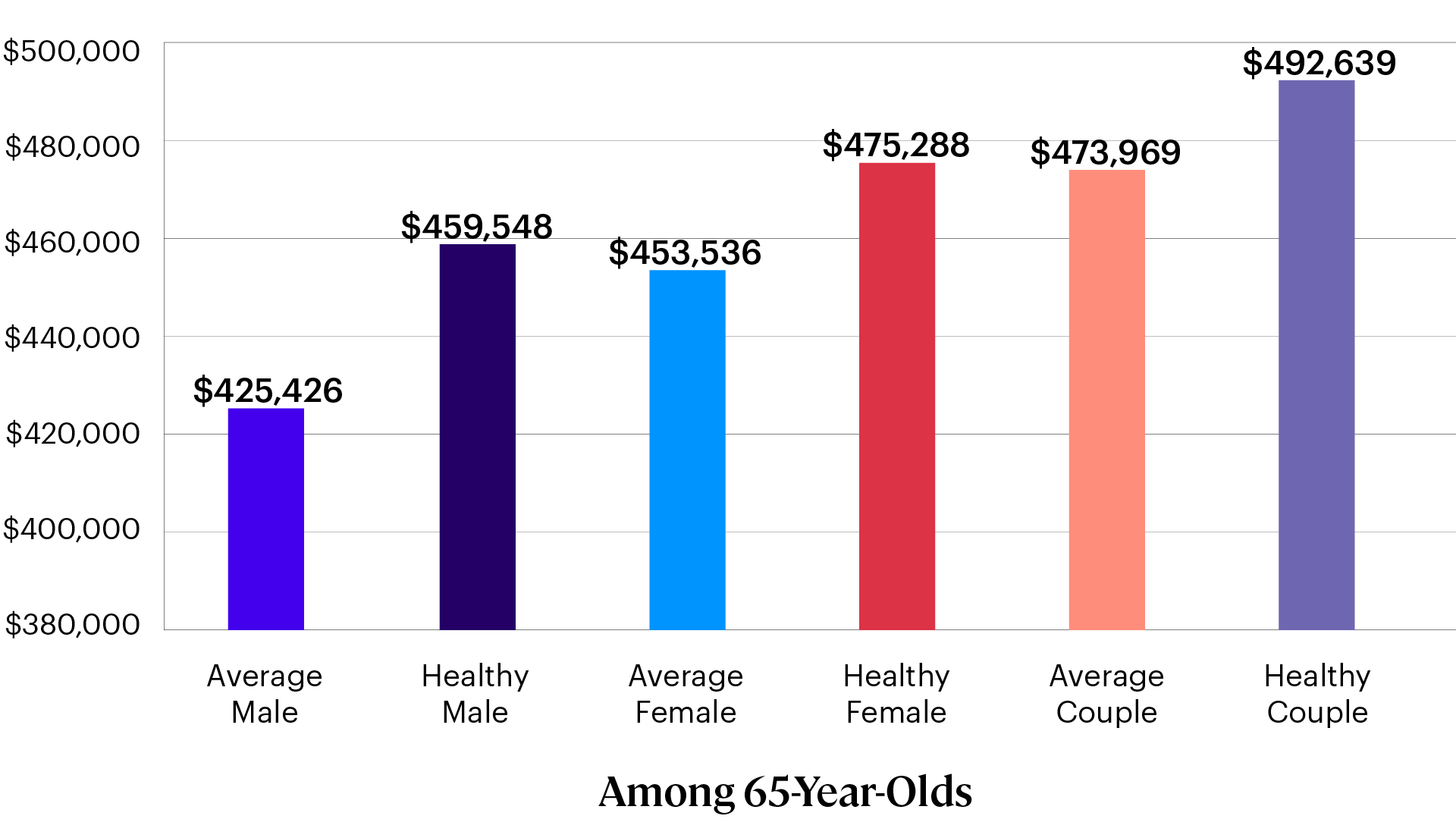
Average male, female, and couple life expectancies based on the 2017 Social Security Administration mortality table. Healthy male, female, and couple life expectancies based on the 2012 Society of Actuaries annuity mortality table. *Cost estimates to achieve an 80% probability of success for a 65-year-old are based on TIPS yields on April 12, 2024.
Although inflation-protected income is more expensive, it can also be more valuable—particularly for healthy Americans who will have to fund longer retirements.
Implications for Planning
Today’s financial planning clients, who are generally healthier and wealthier than the average American, can expect to live significantly longer than their parents, and longer than the average American. Research from the Retirement Income Literacy Study shows that most Americans ages 50 to 75 underestimate the number of years an average retiree will live. Clients of financial advisors are slightly more likely (31%) than unadvised respondents (24%) to correctly answer the longevity literacy question, but 62% either still underestimate or don’t know average longevity.
Advisors can help clients establish a more appropriate planning horizon and make better choices through longevity education. This is especially importance since survey data suggest that individuals who are less longevity-literate are more likely to claim Social Security early and less likely to plan for income into their 90s.
A longer retirement is a more expensive retirement.
Improvements in longevity have several important planning implications:
- A longer retirement is a more expensive retirement. Being longevity literate means recognizing that today’s planning time horizons for healthy clients will extend into their 90s, and for couples even longer. While a longer retirement is good news, funding more years of spending creates a need for creative planning strategies that help retirees get the most out of their saving.
- Research shows that strategies such as tax-efficient distribution planning—in which advisors pay attention to spending down the least tax-efficient assets first and the most tax-efficient assets last, while taking advantage of opportunities to manage tax brackets and using strategic Roth conversions —can extend the life of a portfolio by as much as 20%.
- The higher value of inflation-protected income for healthier clients, and in particular healthier women, means that delayed Social Security claiming is almost always going to provide more retirement wealth than claiming early. Claiming strategies that focus on the expected longevity of a lower-earning spouse can provide an added boost by providing a larger lifetime spousal benefit. For healthy retirees, delayed claiming can reduce the cost of funding a retirement lifestyle by tens or even hundreds of thousands of dollars.
- Finally, retirees can also reduce the cost of funding an income goal by considering the value of transferring the risk of not knowing how long they will need to fund an income goal to an institution. Annuities allow a retiree to spend as if they will live to about an average longevity, freeing up more dollars to spend earlier in retirement and protecting against the risk of living beyond their planning horizon.
The Retirement Income Literacy Study provides actionable insights into older Americans’ financial literacy on 12 retirement topics, including longevity planning.
More From The College:
Get specialized retirement planning knowledge with our RICP® Program.
2024-2025: A Critical Window for Retirement and Estate Planning

When the closing bell rang at the end of 2023, surging stock market values left retirement accounts bulging. But supersized IRA balances are not necessarily good news.
In a recent webcast The American College of Financial Services held exclusively on its subscription-based learning platform Knowledge Hub+, IRA expert and professor of practice Ed Slott, CPA explained that a sizable IRA is little more than a ticking tax time bomb primed to explode in years to come. That’s because through the required minimum distributions (RMDs) mechanism, IRAs create a stream of taxable income – and the bigger the IRA, the bigger the income stream and its associated tax bill.
“In 2023, we had the highest end-of-year stock values of all time. Prepare your clients for larger RMDs and keep in mind that these may get taxed more heavily in the future,” Slott said. “A large IRA balance is just tax waiting to happen. I always tell consumers: your IRA is an IOU to the IRS.”
“A large IRA balance is just tax waiting to happen. I always tell consumers: your IRA is an IOU to the IRS.”
–Ed Slott, CPA
The 2017 Tax Cuts and Jobs Act (TCJA) cut tax rates to historic lows (see Figure 1); however, these favorable rates are scheduled to expire on December 31, 2025, and Slott argued that – against the backdrop of rapidly rising government debt – we’ll likely see rising tax rates soon. That means individuals taking RMDs can expect rising tax bills, and for those with bulging IRA balances, the tax bite could be particularly painful.
Figure 1: Top Federal Income Tax Rates: A Century Snapshot

Further complicating matters, SECURE Act provisions requiring heirs to empty inherited IRAs over 10 years mean those inheriting today’s large accounts may face onerous annual tax liabilities post-2025. This is especially true for heirs who may be in their highest earning years as they’re required to empty their inherited IRAs.
“In the aftermath of the SECURE Act, IRAs are a horrible wealth transfer and estate planning vehicle,” Slott said. “The whole balance of the inherited IRA is going to be taxed in a shorter window and heirs may only have two years left at today's favorable tax rates.”
“In the aftermath of the SECURE Act, IRAs are a horrible wealth transfer and estate planning vehicle.”
–Ed Slott, CPA
IRAs: A Poor Vehicle for Estate Planning
With tax rates poised to rise, tax-deferred vehicles like IRAs are looking increasingly unattractive, particularly for clients who wish to use their retirement savings accounts to benefit their heirs. Advisors must urgently find new ways to structure estates that deliver larger inheritances with lower taxes.
Fortunately, Slott had some good news for those seeking to implement fresh strategies.
Due to the combined impacts of the TCJA and inflation, 2024 and 2025 offer clients a unique opportunity to pay lower taxes as they restructure their estates. Not only are tax rates low by historical standards, but rising inflation has also inflated tax brackets. This means clients can pay lower rates on larger amounts of income (see Figure 2).
Figure 2: 2024 Tax Rates: Joint vs Single Filing
Marginal Tax Rates |
Married Filing Jointly |
Single |
|---|---|---|
10% |
$0–$23,200 |
$0–$11,600 |
12% |
$23,201–$94,300 |
$11,601–$47,150 |
22% |
$94,301–$201,050 |
$47,151–$100,525 |
24% |
$201,051–$383,900 |
$100,526–$191,950 |
32% |
$383,901–$487,450 |
$191,951–$243,725 |
35% |
$487,451–$731,200 |
$243,726–$609,350 |
37% |
Over $731,200 |
Over $609,350 |
Knowledge Hub+. Ed Slott’s Top Retirement Tax Planning Opportunities for 2024. April 2024.
“Look how much income can come out at 22%, or 24%,” Slott said. “Hundreds of thousands of dollars of taxable income can be withdrawn at these unbelievably low rates, and this is only going to go on for two more years.”
“Hundreds of thousands of dollars of taxable income can be withdrawn at these unbelievably low rates, and this is only going to go on for two more years.”
–Ed Slott, CPA
All of this makes 2024-2025 an opportune time to explore the possibility of restructuring your clients’ estates by migrating assets from tax-deferred vehicles like IRAs to tax-free vehicles such as Roth IRAs or life insurance products.
The idea, Slott says, is to pursue an aggressive, proactive IRA withdrawal strategy focused on reducing the balances held in tax deferred accounts and migrating assets to tax-free options. Instead of simply taking the RMD, clients would withdraw greater amounts and convert the proceeds into Roth IRAs, life insurance, or other vehicles depending on their needs.
Slott acknowledged clients may balk at the idea of taking large distributions and paying the associated tax bills; however, he also pointed out balances held in IRAs are inevitably going to be taxed – the only question is when and at what rate. By choosing to take bigger distributions and pay tax now, when tax rates are low and tax brackets are generous, clients can protect themselves against future tax increases. And by transferring assets to instruments like Roth IRAs or life insurance, clients can create wealth transfer vehicles that enable them to pass on larger inheritances tax-free.
Slott warned that this strategy isn’t necessarily right for every client; charitably inclined clients, for example, may find it preferable to use their IRAs as a vehicle for charitable giving either through qualified charitable distributions (QCDs) or charitable remainder trusts (CRTs). Very high net worth clients, on the other hand, may wish to avail themselves of today’s generous gifting allowances to transfer assets to heirs before their passing.
Advisors should also consider the specific circumstances of each client – clients who may need funds in the short term might not be suitable candidates for a Roth conversion, for example.
“The retirement savings tax rules are the most complex in all the tax code,” said Slott. “They affect almost every client you have. And the laws are not only complex, but they are also unforgiving. We've seen mistakes that have cost clients a fortune and cost advisors their clients. Don't let it happen to you. Be proactive. Learn what your clients need you to know to help them protect and preserve their retirement savings.”
“Retirement savings tax rules are complex and unforgiving. We’ve seen mistakes that have cost clients a fortune and cost advisors their clients. Don’t let it happen to you.”–Ed Slott, CPA
When it comes to retirement tax planning, there are many twists and turns. Want to learn more? Enroll now in Ed Slott & Company's IRA Success, an e-learning experience that helps financial professionals understand the complexities of IRA distribution planning and qualifies for up to 27.5 CE credit hours. You can also find content from Ed Slott, CPA on Knowledge Hub+, now available exclusively to members of The College’s Professional Recertification Program – and coming soon to the general public!
Retirement Planning On-Demand Webcasts
Help Your Clients Plan for a Better Retirement
Watch as leaders from the Center for Retirement Income take part in an informational discussion on the importance of tailoring withdrawal strategies to individual lifestyle goals. They’ll also offer insights on creating a retirement income plan that ensures financial security while meeting clients’ personal goals. Get valuable insights that will help you guide clients through complex retirement planning topics.
Shares The Retirement Income Illiterate

In this episode of our Shares podcast, host Eric Ludwig, PhD, CFP® speaks with fellow researcher Chet Bennetts, CFP®, ChFC®, CLU®, RICP®, CLF® about some of the 2023 study’s most important takeaways and how advisors can use these insights to better partner with their clients for critical retirement planning conversations.
Chet Bennetts, CFP®, ChFC®, CLU®, RICP®, CLF® is an assistant professor of financial planning and director of the Chartered Financial Consultant® (ChFC®) and CFP® Certification Education Programs at The American College of Financial Services. With over 20 years in the financial services industry, Bennetts has served in roles from customer service, to being a financial planner, to managing 80 advisors in over five states. After serving in the Marine Corps for over eight years, both active and reserve, Bennetts was medically discharged when he returned from Iraq in 2005. In staying connected with the military communities, he serves as an on-demand DoD contractor, providing free financial counseling and planning services to service members and their families. His research focus and passion is in the area of behavioral finance — specifically how financial wellbeing affects physical and psychological wellbeing — among service members and veterans.
Any views or opinions expressed in this podcast are the hosts’ and guests' own and do not necessarily represent those of The American College of Financial Services.